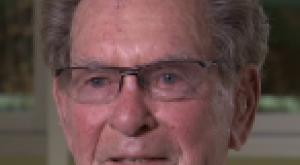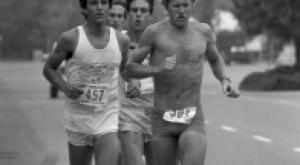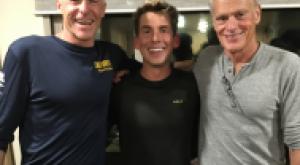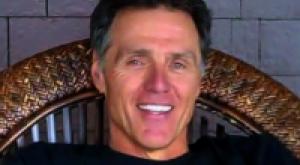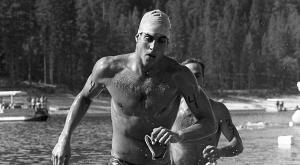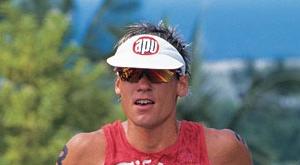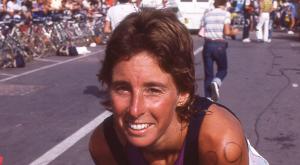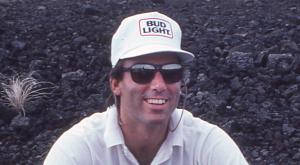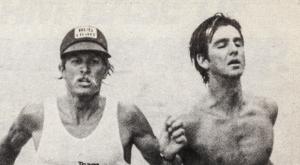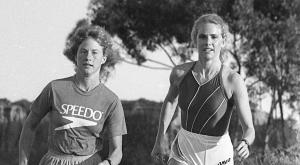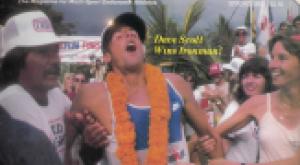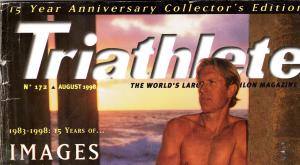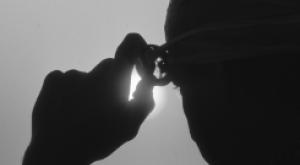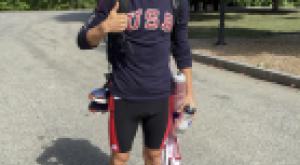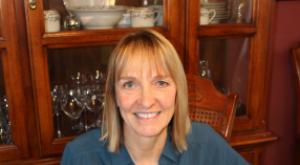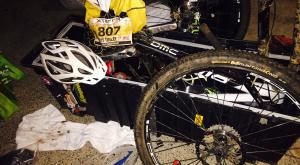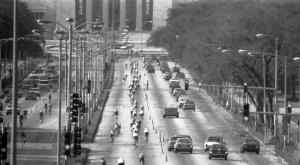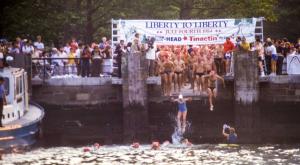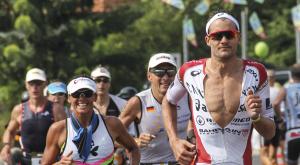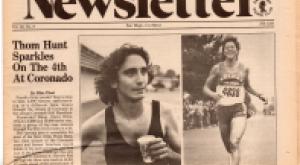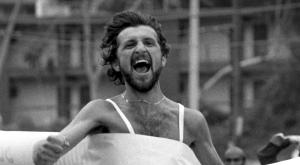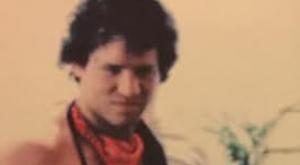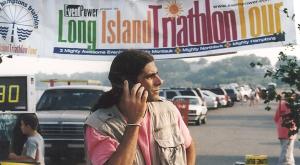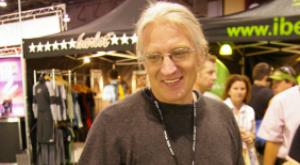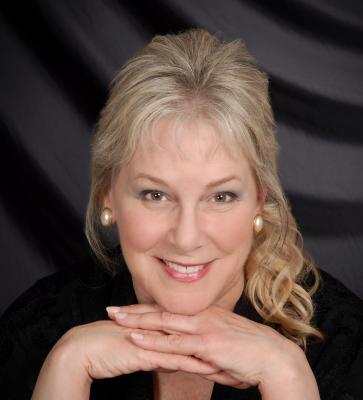
Valerie Silk in a contemporary photograph
The Ironman was over and there was no particular place to go.
It was the fall of 1990-something and any chance this kingly race had of retaining its former innocence was left to negotiate; an already-older woman vs. The World of Commerce. The sides faced off: a bag of cash, a need-to-leave-while-she-could, and subsequent legal notices to appear. One of the greatest endurance sport events in modern history was being monetarily-transferred to something called a third party, and those of us quasi-innocent athletes lurking about the finish line of the Ironman Triathlon World Championship with a water bottle or an IV bag or an emblematic phallus courtesy of (enter related sponsor product here: soap-on-a-rope, hardened metal-man symbolic trophy with requisite arms outstretched in missionary accomplishment, et al.) In our soft naïve hands lay the quietly ambiguous procreation of this sweet and beautiful idea. Who of us had any idea that the Ironman Triathlon World Championship was entering the world of pornographic reproduction?
Whatevahs, Brah. As long as the checks don’t bounce and the beer don’t warm
The event had been sold to somebody in Florida, an ophthalmologist, it was rumored. Perhaps he’d see things differently. Perhaps he had a mind for business and professionalism. Hell, that’s all the pros wanted …a chance to earn a few bucks for rent. Valerie Silk, owner/operator of the Ironman, was leaving the house. What may or may not exist in her wake was to be determined by those seeking purchase in the possibilities; the sugar-coated seeds sewn as Silk’s own material eggs.
******
The stories of this storied event when Ms. Valerie Silk willingly transferred her 51% interest in the Ironman Triathlon are rife with sub-narratives of roots-marketing, environmental tightropes, volunteerism, and great sums lost and gained.
Inc. Magazine cover stories have been famously absent, perhaps in service of, or even protection of the accidental brilliance of brand growth. The Ironman (as brand and subcultural phenomenon) had, largely on the back of a quietly tall blonde from a family of eight siblings from St. Petersburg, Florida, become famous and valuable.
Silk had little to no experience in sports production and management before taking on the role as Race Director in 1980 and admittedly, was naïve to the cut-throat tactics of high-level commercial sport. But—and it’s a capital But--not in spite of, but because of her treatment of the event and its participants as if they’d sprung from her own womb, the event and the brand grew slowly, distilled by word-of-mouth, myth, and secret handshake kinds of means. The Ironman Triathlon’s cultural capitalization advanced over a dozen years before its socioeconomic value was in synch with Silk’s appetite (or lack thereof) for continuing her leadership. So, in a sale to Dr. James Gills, the eye doc from Florida with an eye for smart investment, Silk disappeared into the fold of normality as if she had never built a foundation for a multisport high rise.
And nothing after the sale of the event in late 1989 was ever the same with Ironman.
There are precious few magically-untold tales in the world of modern sports and triathletes in particular, tend to avoid the mystical minutia. We are all too happy to dodge the dripping nostalgia; all too ready to forward-speak of the potential and the possibilities while those figures who built the platforms upon which we dance get lost to time and tide. Valerie Silk, owner/producer of the Ironman Triathlon between 1980 and 1990 was that quietly-curious blonde from Florida whose matriarchal naiveté quite accidentally shape-shifted the post millennium endurance sports movement. And in the process, captured and catapulted an idea that is now nearly an eight-figure brand.
Excuse me but WTF: the Ironman Triathlon is now, in the Fall of 2015, in play to be sold to Dalian Wanda, a Chinese multinational conglomerate, for a reported $850million. (http://www.reuters.com/article/2015/08/06/us-ironman-m-a-dalian-wanda-idUSKCN0QB2M120150806) Who’d a thunk so much toil and trouble was worth so much ying and Yuan?
******
The story of this transfer of brand if not ideology and purpose might begin in the middle--en media res--but the truer tale of Valerie Silk’s contributions to the Ironman Triathlon if not the world of mass participatory sports, is best told at the bookends. When our bawdry band of professional “full-distance” athletes stood fully around the 1990s finish lines, we had all but missed the grandeur of Ms. Silk’s contributions. She was the person who challenged us, who we pretended to love for her love but falsely-hated for her early dismissal of all-things-professional. I didn’t know if I fully-liked here then but respect her on the level of love now for her commitment to principal if not something wonderfully accepting, if not forgiving, that comes with the passing of time. Ms. Silk contributed to my athletic past more than most if not all in the category of race production. Valerie gave us the canvas and said go…paint something.
And so her tale begins here, at the margins, a place where she began and is now interred as the rest of triathlon muddles in their own self-importance.

Valerie Silk, on the Kailua Pier, before the October, 1982 Ironman. (Mike Plant photo)
ST (Scott Tinley): Val, can you talk about the first time that you understood what you had ‘inherited’ in the form of the Ironman? I am assuming it was just something that (your ex-husband) Hank didn’t want and you took over in the divorce. Was there ever an ‘a ha’ moment when you thought, well, this could be something really special?
VS (Valerie Silk) As far as having an ‘a-ha’ moment, when I suddenly saw the Ironman as inherently special, (well) I can’t say that ever happened. It took me a while to warm up to the idea of the Ironman in the first place, even after becoming race director. Initially, I couldn’t relate to it on any level, because I thought it was downright crazy.
When the Ironman became my responsibility in 1980, my view of it was entirely separated from the fact that it was a sports event. For me, it was merely a vehicle through which I could achieve what I was driven to achieve at that particular time in my life, which was to do something that would have a positive, life-changing influence on people. That was it. It wouldn’t have mattered to me whether I organized a grueling race or an evening at the symphony. My aim would have been the same. At that particular time in my life, something in me simply needed to create a context in which people could be moved in their very souls in a way that transcended their daily lives and would become better people for it.
As an aside: I was not a Christian then. I am now. I recognize now that there was a seeking in me, even then, for the transcendent, which ultimately would be found, not in an event, but in the Person and work of Christ.
The Ironman wasn’t something divvied up in my divorce from Hank. Quite unfortunately, I was naïve about such things and didn’t make a clean break with him in the $75 divorce I obtained. So, much to my detriment, I remained part owner of the Nautilus Fitness Centers, which eventually went under, while he remained part owner of The Hawaiian Triathlon Corp., until I bought him out a few years later.
It wasn’t so much that Hank didn’t want the Ironman, and therefore I took it over in the divorce. It was more a simple matter of timing and the confluence of events.
ST: Can you talk a bit more specifically about the details of how you acquired the Ironman
VS: First, I determined I could no longer work with Hank in the fitness centers. So I pulled away from the business.
Secondly, I went back to school, but Hank wasn’t happy that I wasn’t working and generating income.
So thirdly, I began looking for some kind of work to do.
Fourthly, Ironman ’80 had just finished. The toll it took on everyone at Nautilus was obvious. I could see the race needed one person with a singular focus on its production, rather than a business trying to stage the event while conducting its regular business operations.
Fifthly and finally, I was searching for a context into which to pour my own desire for creating something that would be a positive influence on people.
Voila! The Ironman presented itself to me. I mentioned to Hank that I wanted to see what I could do with it. He didn’t object. I think he was relieved to have the burden lifted from Nautilus.
ST: But there must’ve been a certain period when you had some notion that the event was something more than a few dozen crazies looking for something different.
VS: I don’t remember any particular moment, but I do remember realizing after the first couple of races that there was clearly a growing interest in the event, which I never anticipated. Because I was very much goal oriented, I began setting some long-range goals for the Ironman in 1982, mostly having to do with the development of qualifying races, since it was evident that some sort of qualifying system would eventually be necessary. I dared to think in terms of Ironman events around the world as qualifiers. At the time, that seemed an outlandish idea.
I also envisioned the eventual merchandising of products with our logo. A graphics design company in Honolulu created the logo, for which I paid the meager sum of $75. Of course, at the time, I had no idea how meaningful that logo would become. Certainly, neither did the artist, whom I understand is rather sensitive about discussing the subject these days.
ST: You were married at a young age and set off to see the world with a backpack and then landed in Honolulu. You had what, nine siblings from St. Petersburg? That must have affected your early decisions about how to manage (nurture?) the event.
VS: Actually, I had just turned 21 when I married Hank in Nov. 1971.
I come from a family of eight children. I have an older and a younger brother and five sisters. We all grew up in the same house in St. Petersburg, FL, and we all still live close to the old neighborhood. We have deep roots in Pinellas County that go back generations.
Hank, on the other hand, had no roots. He was a wanderer from the beginning. So it was his idea that we travel around the world, working as we went to earn enough money to keep going. When we got to Hawaii, in the early 1970s, we ran out of money and never left.
I never really thought about whether my background played a part in how I managed the Ironman. I suppose our backgrounds necessarily influence our lives. Being one of eight children influenced me in as much as I determined to avoid having children of my own. Of course, I deeply regret that decision now.
I was the second oldest daughter in my family, which meant I carried a lot of responsibility for those younger than I. When I was old enough to leave home, I figured I’d played the mother role long enough.
Now I realize that was utter selfishness. As a father, you know the selflessness required in being a parent. I chose to avoid that for the unfettered freedom of going my own way, but ironically, I gave up everything for a decade for the sake of the Ironman, which was like a kid to me. In retrospect, I’m sure it would have been a whole lot less work and infinitely more rewarding if I’d been a real mom with a real kid instead.
I did relate in a maternal way towards the Ironman, especially in the early years of the race, when I would talk at length on the phone with those who were so alone in their training. Everyone around them thought they were crazy to be doing what they were doing. Of course, so did I, but I eventually gained an enormous respect for the dedication, discipline, and sacrifice of those who set a goal for themselves and never wavered from it. They taught me a lot. As a result, I felt the weight of needing to carefully prepare a venue for them that would afford every opportunity for them to achieve what they set out to do and to bring their dream to fruition.
ST: That sound quite matronly, don’t you think?
VS: As time went on and the Ironman grew, I became fiercely protective of the event and staunchly determined to preserve its finest qualities, not to bow to trends or to be persuaded by gimmicks, such as a million-dollar sponsorship, if I would just add a fourth event of weight-lifting at the end of the race. (That would have gone over well, don’t you think?)
I remember wrestling with many tough decisions and thinking like a parent: Do I give in to the pleas of the child, or do I deny its heart’s desire for the long-term benefit?
ST: How difficult was it for you to move the course to Kona? What were a few of the many factors that you must’ve considered in that decision?
VS: It really wasn’t difficult at all to settle on Kona, once I saw it. My heart was first drawn to Kauai, but there was no reasonable way to accommodate the Ironman on that small island. I considered Maui next, but the same applied there.
Kona was a sleepy little fishing village, but that long, straight, wide-shouldered, lightly traveled (at the time) Queen K Highway along the west coast of the Big Island made the decision easy—though not immediate. At first, I thought the lava fields along the Queen K were much too boring for the race to go in that direction. So I originally took the course south, until someone, with a lot more sense than I had, explained to me how treacherous it would be to have bikers winding along the mountain roads, in the dark, alongside steep cliffs.
So I abandoned what I thought would certainly provide “beauty shots” for ABC (Wide World of Sports) and reversed the course, taking it north through miles and miles of desolate black lava fields. Of course, those lava fields are now an integral part of the character of the Ironman.
ST: Many of us remember those years between 1980 and 1990 fondly, even whimsically. But some of also remember the frustrations we had (with you and the event) in trying to push the Ironman toward professionalism in an effort to find ways to offer athletes compensation for their efforts. Can you discuss your thoughts during those mid 80s with respect to prize money, sponsorship, etc.?
VS: The issue of prize money was probably the toughest struggle for me of any throughout my tenure with the Ironman. I was dedicated to making the race available to the “Everyman,” as it had been from its inception. The seniors in the race, as well as the middle- and back-of-the-packers, were colorful, interesting, and sometimes eccentric people. They provided a rich texture to the whole fabric of the Ironman. As the race grew and qualifying became a necessity, many of those people were squeezed out, which I considered a loss.
We maintained a lottery, which grew smaller over the years. I also retained for myself a certain number of discretionary spaces (I think it was 100), in which I allowed entry to whomever I chose. I guarded those slots jealously.
Over a long period of time, I listened to many, many voices about the subject of prize money, solicited and otherwise. Some pleaded with me not to give in to pressure and to keep the Ironman an amateur event. Some insisted that I had to provide a purse, or the race would die.
My closest advisors—those on my staff and my volunteer directors—were divided three ways. Some felt it would be good to offer money; some were dead set against it; most actually didn’t think it would matter one way or the other.
Gratefully, my sponsors, ABC, and all other business entities with whom I interacted remained absolutely silent on the issue. Never once did I ever sense any pressure from them to do one thing or another. They simply waited for me to make a decision.
My biggest concern was that the introduction of prize money would change the essential character of the Ironman. I feared only the elites would have access, and the race would become all business, cold and sterile.
ST: What about Bob Bright in 1986? Was there more and more pressure being put on you to offer prize money? Can you talk about the effects of Steve Drogin (from La Jolla) when he anonymously donated the $100k for prize money in 1986? How did that unfold?
VS: It was just a couple of days after the 1985 race that I got a call from one of my press coordinators, who told me that someone named Steve Drogin wanted to meet me for breakfast the next morning. I had never heard of the man. I had a flight to go home to Honolulu the next morning and wasn’t interested in meeting him, but I was strongly advised to keep the breakfast date. I finally relented.
We met for breakfast at the Kona Surf, where Steve very diplomatically offered his opinion that I should introduce prize money at the next Ironman. I listened patiently, but I had no idea where this was going, or why I needed to cancel my flight home just to hear yet another opinion from someone I didn’t know about something that had become such an albatross around my neck.
Then he said he wanted to offer a proposal.
I tell you this because I’ve been amazed over the past few years how many people seem to know about Drogin’s offer. I kept silent for a couple of decades, because I wanted to honor his request that he remain anonymous. But when I discovered that his contribution to the Ironman seemed to be common knowledge, and in light of his passing several years ago, I no longer feel the necessity of maintaining silence.
The proposal Steve made was the following:
1.He would make a one-time-only gift of $100,000, no strings attached.
2.The money was to be used exclusively for a purse at the next year’s event (he left the allocation of the money up to me).
3.If I chose not to accept, the offer would be taken off the table and would not be available again.
4.He must remain anonymous.
Well, I never saw that coming. I simply didn’t know what to say. I knew I had reached a critical juncture in the life of the Ironman. I had a keen sense that I needed to be very careful about what I did, because the ramifications of this would be long term.
I asked for time to consider. I don’t remember how much time I requested. It may have been two weeks; it might have been a month. I had a lot of research to do and needed time to give this careful thought.
I knew if I accepted, there would be no going back. I would have the responsibility of raising the funds in the future. No small task.
There was no way I wanted to risk having the Ironman go down the same road as the Diamond Triathlon and other races that made promises of money that weren’t fulfilled. I simply could never let that happen.
The first thing I wanted to do was seek counsel from two well-respected race directors. One was Fred Lebow of the New York Marathon, who decided to bring prize money into his race after a long history without. The other was Mike Aisner, Director of the prestigious Coors Classic, who offered no purse.
I flew to New York, then Boulder, to meet with both men. They were gracious and informative. Fred said he thought, on balance, prize money was a good move for New York, though it did have its problems. Mike was quite firm in his stance against a purse, pretty much for the same reason I had against it—the probable change in the character of the race.
Another man’s name kept coming up in my conversations with Fred and Mike, and that was the name of Bob Bright. He was an enigmatic figure, but it was clear to me that he was viewed with a healthy respect. He created the Chicago Marathon with the deliberate intention of going head to head with Lebow by offering sizeable money and staging his event in close proximity to New York, which I thought was an unseemly move, frankly, though he was unquestionably successful.
When I returned to Honolulu, I wanted to talk to Bob Bright, but I called Fred Lebow first and asked if he had any objection to that. I wasn’t sure whether they were on speaking terms. I didn’t want to offend Fred, who assured me that he and Bob were friendly towards one another and told me that I should speak with Bob.
So I called him, and I was fascinated by all he had to say. He was certainly colorful in style, obviously streetwise, and marketing savvy. My conversation with him was very instrumental in swaying me in the direction of prize money, but I still had some time left to consider before my deadline with Steve Drogin.
I spoke with my staff and directors about what I was thinking. As always, they were graciously supportive and encouraging.
At some point, I decided in favor of accepting Steve’s offer. Bob Bright flew to Hawaii to discuss the matter in more depth with me, and then we met with Steve in Kona.
Bob and Steve hit it off right away. Bob offered to help me with the transition to prize money by handling negotiations with select triathletes, who would have certain expenses paid. This was all new to me. So I was more than happy to let him handle that area of the race for me.
In retrospect, it was a good thing to introduce prize money. It turned out to be an exciting addition and took the Ironman to a new level. It was an agonizing decision for me, and it was terrifying. I had no idea how I would raise the money. I just knew I had to do it, now that the die was cast.
ST: Who were your confidants in those early years? What about someone like Rodney Jacobs from Freewheelin Films? Didn’t he negotiate that first contract with Anheuser Busch? (Budlight). Was it hard to find people to trust in the world of sports marketing and management?
VS: My closest confidant in the very early days was Earl Yamaguchi. Earl was a key member of the Nautilus staff and, as such, was very much involved with the Ironman from its beginning—including 1978, with the training of Gordon Haller and the coordination of his support crew; in 1979, with Nautilus sponsorship of the Ironman; and in 1980, when Nautilus took over responsibility for the race from John and Judy Collins.
Earl left Nautilus to help me organize the event when I became Race Director, and he remained with the Ironman until after I left. He was a man of unassailable character, an indefatigable worker, highly organized, and steadfastly loyal. He worked quietly behind the scenes and was productive beyond measure. Earl was a man of few words, not at all given to idle chatter. When he spoke, we listened because he carefully considered his words before speaking, and his thoughts were always valuable.
The first three events I directed (’81 and both events in ’82) were organized from my condo in Honolulu. Earl used to sit on my living room floor and use a glass-top coffee table as his desk. I worked at a little telephone counter in my kitchen, and a secretary worked in an office in the second bedroom.
I count it a high privilege to have worked with Earl for so many years and to know his wonderful wife, Wanda. It cut me to the heart when I learned that Earl received notice of immediate termination by way of a cryptic message faxed from the WTC office in Florida to the Ironman office in Honolulu, not long after the sale of the company. He was an honorable man and deserved to be treated more honorably than that.
Rodney Jacobs on the other hand…well, everything Earl was Jacobs was not. I was painfully stupid when it came to dealing with that man. Recalling the whole sorry episode with him is an exercise in unpleasantness for me.
Yes, Jacobs is the one who first brought the idea to me of an Anheuser-Busch title sponsorship. He had a film company, in Aspen, and apparently had previously produced some commercials for A-B. At some point after the ’81 race, he contacted me and requested a meeting on behalf of his company and Anheuser-Busch.
I still remember Jacobs sitting in my living room, telling me about a new beer A-B was about to introduce in Hawaii. As I remember, Hawaii was to be the first test market for the beer, called Budweiser Light (later shortened to Bud Light). The brewery wanted to use the Ironman as the vehicle for launching their new product.
The initial offer Jacobs proposed was a 3-year contract with Anheuser-Busch at $15,000 a year. For that, A-B would get title billing. Jacobs’ company, Freewheelin’ Films, would produce a documentary of the Ironman, which he would market to network affiliates. In addition, he would use footage from the documentary to produce a Bud Light commercial.
But I had a contract with ABC Sports, which gave them exclusive video and broadcast rights to the race. That contract unambiguously banned any and all camera crews, except ABC’s, from being on the course on race day.
I explained this conflict to Jacobs. He confidently assured me that the networks always put that type of impossible-to-enforce language in their contracts, but it was easily circumvented. The Ironman was conducted on a public highway, after all. Anyone with a camera could have legitimate access, and ABC couldn’t do anything about it, he said. But I needn’t worry. He had a great working relationship with ABC. He knew all the people at the network and would talk to them about an arrangement whereby ABC and Freewheelin’ Films would share the course. He claimed that he worked side-by-side with ABC at events all the time.
Furthermore, because Anheuser-Busch spent an incredible amount of advertising dollars with ABC, they wielded extraordinary leverage with the network. So I could be assured they also would see to it that there would be no problem with Freewheelin’s cameras on the course.
I was wary, as well I should have been, but I was also brand new to this game. Maybe backroom deals like this were commonplace between corporate giants like ABC and Anheuser-Busch. What did I know?
I made the dreadful mistake of actually believing this lie, though I admit that I wanted it to be true. At least I had the presence of mind to refuse a 3-year contract at $15,000 a year, as tempting as it was. At that early stage in the development of the Ironman, that was a large sum of money and was very much needed. Nevertheless, I agreed to no more than one year, with the stipulation that Jacobs and A-B would resolve the conflict with ABC. He gave me every assurance they would.
After that meeting, Jacobs left Hawaii, only to return soon thereafter with his good friend, John Lodge, former manager of national sales promotion for Anheuser-Busch. The three of us met in my living room, and I reiterated my concern to both men about the obvious conflict with my contract with ABC. Both Jacobs and Lodge gave me their word that they would call ABC when they returned to their respective offices and would make arrangements to ensure there would be no problem on race day.
With that assurance, I signed a one-year contract with A-B, which stipulated access for Freewheelin’s camera crews to be on the course on race day.
Even as I write this I’m shaking my head at my utter stupidity. I very wrongly assumed these were the big boys, who knew how the game was played in the big league. I was mistaken to think that I should stand aside and let them work out a deal in the way deals like this are done by those who understand such things. It just didn’t occur to me that they would flat out lie…
Author’s Note (ST): In full discloser, I have been a close friend of Rodney Jacobs for nearly 35 years and have heard him regale the story of his early dealings with Silk, Ironman, and the A-B contract from 1982 no less than two dozen times. In each and every case, Jacobs speaks fondly, with great respect for Valerie and her commitment to the event. But in service of her own memory and journalistic integrity, I print her reply here.
VS: Several times, over the ensuing months leading up to Ironman race week, I left message after message for Jacobs, in Aspen, and Lodge, in St. Louis. I kept pressing for some word on the progress of their discussions with ABC. Did they make contact with Bob Iger? Did they have the issue settled? What was the status? At first I was told they were working on it. Later, the only response was silence.
In answer to your question whether it was hard to find people to trust in the area of sports marketing and management:
Though I had an abysmal experience with Jacobs and Lodge, I really didn’t find too many people I couldn’t trust. I seem to remember being burned a few times, but those occurrences weren’t significant enough for me to remember them.
What I generally experienced with sports marketing agents was that I always reached a point where I didn’t feel I needed them. When it came right down to it, I was the one who lived and breathed the race, and there really wasn’t anyone else who could convey its essence to a potential sponsor the way I wanted it conveyed. I would have loved to delegate the solicitation of sponsors to someone else, but whenever I did that, I always found that a marketing agent could speak only in the context of dollars. I could tell people about what the Ironman was, the incredible stories of the people involved, and the exciting spectacle of race week where lives were changed.
ST: The business decision to offer 49% ownership to a partner, was that correct? Can you talk about how might’ve changed your approach to managing the event? Do you remember the details?
VS: I did have a 49% partner by the name of Don Carlsmith, who was an attorney in Honolulu. In all the years I partnered with Don, I remember meeting with him only once or twice.
The person I dealt with, on Don’s behalf, was a delightful man named Blitz Fox. Blitz and his wife, Mary, lived on the Big Island. I believe he managed Don’s Big Island property holdings, as well as his mainland interests.
Blitz was also an Ironman volunteer, who once mentioned to me that, if I ever needed any help with the Ironman, to let him know. At the time, I couldn’t imagine that I would, but then a problem developed with my ex-husband, Hank.
Hank’s bad business practices and poor management of the Nautilus facilities led to the company’s eventual ruin, but I didn’t know how bad things were until it was too late. Hank and I divorced in ’81 and had very little to do with one another after that, even though I was still on the papers for Nautilus, and Hank was part owner of The Hawaiian Triathlon Corp. That arrangement was blissful ignorance on my part. I had to learn the hard way that a cheap, $75 divorce doesn’t get you sound counsel. I was too naïve to realize the importance of severing all business ties at the time of divorce.
Hank visited the race in Kona one year. I think it was the Oct. ’82 event. I didn’t even know he was there. Somehow he managed to have a conversation with the man who was my business manager at the time. Unfortunately, he told Hank that the Ironman was finally starting to show some signs of solvency, and the future looked bright. When I later learned that Hank had been given that information, I shuddered. I wondered if he might one day try to siphon funds from the Ironman.
A few months later, Hank invited me to dinner. I was foolish enough to think he wanted to visit for old time’s sake. We met at a nice restaurant in Honolulu. The conversation initially was quite cordial. Then the moment came when Hank asked me to loan him $30,000 so he could make payroll.
I told him I didn’t have $30,000. He suggested I apply for a loan. I said I didn’t have any reason to take out a loan. He told me to “make something up.” I explained that I had an excellent relationship with my banker and didn’t want to jeopardize that. I also told him the Ironman couldn’t survive losing that much money, if he didn’t pay it back. He gave me complete assurance that he most certainly would pay it back, but I knew he wouldn’t.
He outlined his plan for repayment and was sincere about reimbursing the money. I still said no. Then he gave me the familiar: “if you cared anything about me and had any sympathy for what I’m going through and how hard I’m working…”
I really wanted to help. I felt sorry for him, and a couple of times, I almost gave in. It took everything in me to hold firm, but I knew the Ironman could not withstand losing that kind of money. The race was just beginning to show signs of standing on its own, but it was still financially fragile.
When Hank finally realized he wasn’t going to get the money, he turned indignant. He stood up from the table, threw his napkin at me and said, “This one’s on you.” Then he walked out. The waiter came over to me and sympathetically said, “Nice guy, huh?”
I paid the tab and left, embarrassed, feeling horrible, and wondering if I did the right thing. My head knew it was absolutely the right thing, but my heart was torn.
As I drove away from the restaurant, a light rain was falling in the night. I saw Hank walking in the rain, heading back to Nautilus, located a few blocks away in the basement of a bank building in Honolulu. His hands were in his pockets; his head was down. I came so close to pulling over and telling him I changed my mind and would give him the money. My foot hovered over the brake, ready to stop the car, but at the last second, my head overruled my heart. I drove past him and went home.
It wasn’t too long after that, that a man named Harry Flagg paid me a visit in my office. He was a cutthroat business consultant in Hawaii, and apparently was giving Hank advice. I knew to brace myself the second he walked in.
Flagg sat across the desk from me and, in a few words, delivered an ultimatum. I was given a deadline—the exact hour, date, and location—where I was to deliver a certified check in the amount of $145,000 to buy out Hank’s interest in the Ironman. The amount was nonnegotiable. I was not to contact Hank about the matter. There would be no further discussion after he left my office. I would either meet the deadline with a certified check in the amount specified, or Hank would be ready to file with the court to have me removed as President and Race Director of the Ironman.
Their timing was exquisite. The ’83 race was only days away.
At the finish line that year, when I wasn’t hanging leis around the necks of Ironman finishers, I was having a conversation with Blitz Fox about what just happened, and I was asking him for the help he offered months before. After race week was over and things calmed down in Kona, I joined Blitz for breakfast. We continued the conversation we started at the finish line.
He was heading to Honolulu the next day, and so was I. He offered me a ride in his plane. I was always terrified of flying. He flew a little 2-engine prop plane, which didn’t help my fears, but I flew with him anyway. He arranged a meeting with Don Carlsmith, and eventually a deal was made. Don paid me $145,000. He got 49 percent of The Hawaiian Triathlon Corp. I gave the money to Hank. Nautilus soon went under and Hank went underground, where he’s been ever since.
Don was as silent a partner as any silent partner could ever be. I’m so grateful he was there to help when I needed it. It was a good and friendly arrangement, which never altered the way I conducted business. Blitz and I met occasionally to discuss the Ironman. Otherwise, I just kept doing what I was doing.
ST: I want to confirm the details of the 1982 finish with Julie Moss and Kathleen McCartney. As I recall (I was within a few feet of the conversation), Bryce Weismann was berating you for allowing the FreeWheelin’ Film crew on the course while the Julie/Kathleen show erupted. Were you able to witness the episode or did that slip through the cracks as you put out other fires?
VS: I think the first time I ever went public with this story was when I was invited by Jim Curl to speak at a race directors’ conference in San Diego. I can’t remember the exact year. It was around 2000.
I’ll pick up where I left off in my response to Question #6, where I was trying to reach Rodney Jacobs, of Freewheelin’ Films, at his office in Aspen, and John Lodge at Anheuser-Busch in St. Louis, to no avail.
I was finally on my way to Kona for race week, having never heard from Jacobs or Lodge that they made good on their word to contact ABC about having Freewheelin’s cameras on the course on race day. I was greatly unsettled about this unfinished business. I wanted to believe all the details had been worked out. A-B would never invest in the production of a documentary and a television commercial without first making sure they had the right to do it, would they? They knew about the ABC contract. I gave them a copy of it, after all.
I flew to Kona on the same plane as Julie Moss. She sat in the seat directly in front of me. We chatted briefly on the way over. Julie told me she got involved in triathlons because her boyfriend was competing in them. She hoped to do well in the Ironman.
Rodney Jacobs was already in Kona when I got there. The ABC crew had not yet arrived. Jacobs was busy doing his advance work, calculating his camera angles, completely unperturbed that no arrangement had been made with ABC for his cameras to be on the course.
What in the world was going on? I had to assume that this was a style of negotiation well beyond my understanding. These were the big boys who understood how to play this game. Eventually there would be a nod between these two behemoths, and one would give way to the other, right?
When ABC rolled into town, I met the producer, Brice Weisman. Clearly he had no clue about Freewheelin’ Films’ plans for race day. So I went quickly to Jacobs and told him it was time to settle up with Weisman.
Jacobs said, “Brice Weisman? Oh, I know Brice. Be sure to tell him I said hello.”
That’s when I fell to the nadir of my naiveté. I actually went to Weisman and told him that Rodney Jacobs said hello.
I’d never seen hair stand up on the back of anyone’s neck before. I didn't actually see it do that on Weisman’s neck, either, but I’m pretty sure it did when I delivered greetings from Jacobs.
I don’t think it’s an overstatement to say that Weisman came unglued. Oh, he knew Jacobs all right, and he loathed him. Apparently Freewheelin’ Films had quite a reputation in the industry for being a renegade company, showing up at events and getting in the way of the network crews and their shots.
I could avoid the truth no longer. I was in deep trouble.
I joined Anheuser-Busch for dinner one evening at the Kona Surf Hotel and was seated next to Jacobs. I believe John Lodge was also present, and Bruce Dern, the actor who would narrate the documentary, was seated across from me. I tried to engage in light conversation, but I was seething. Finally, at one point I looked Jacobs in the eye and said, “You lied to me, Rodney.”
With a shrug and a grin, he replied, “That’s business, baby.”
Meetings between ABC and Anheuser-Busch ensued. Right up to midnight, the evening before the race, calls were being made to ABC in New York, when finally I spoke with Bob Iger, head of ABC Sports at the time. He reported, in a tired voice, that an uneasy truce had been reached between the two parties. ABC was prepared to move forward with the understanding that they had first rights to every shot, and Jacobs would keep his crews out of their way. It was clear ABC wasn’t at all sure Jacobs would live up to his end of the bargain.
The starting gun went off at 7 a.m., and the race was on. I was hopeful things would go well. Weisman was on edge. Jacobs remained self-assured, of course. Turns out, he had more cameras at the race that day than ABC.
It wasn’t too long after the bike race was underway that I began getting reports from the course that trouble was brewing. Angry words were being exchanged between ABC and Freewheelin’ because Jacobs’ crews were getting in the way of ABC’s shots.
Later I heard that a fistfight had nearly broken out between the cameramen. This was before the bikers had even gone as far as Hawi. I could do nothing but wait back at the pier. There were still many hours ahead before the race would be over.
Jim Lampley was color commentator for ABC that year. After you finished the race, Lampley came to me on the pier and asked if I would respond to some questions. I agreed, and with cameras rolling, he began asking.
It soon became clear this was no benign interview. I was being interrogated. Lampley asked if the Ironman had a rule against all outside support for the triathletes. I said that we did. He asked if I knew that Bruce Dern had been handing wet sponges to the lead runners. He wanted to know if that was a violation of our rule against individual support. He asked whether I thought that would provide an unfair advantage that might affect the outcome of the race.
I could see this was going nowhere good. So I admitted that I wasn’t aware Dern had passed sponges to some of the runners, but whatever small advantage that might provide, I doubted that it was as significant as the draft provided the lead bikers by the ABC camera van. With that, Lampley said, “Cut. We’re done,” and the interview was over.
Later that evening, Weisman found me on the pier and asked if he could show me some footage of the race. He led me to a camera van parked under a huge banyan tree, just beyond the finish line. I sat with him in the van while he showed me segment after segment of videotape of the bike race, saying this shot was ruined, or that shot was compromised, because Freewheelin’ Films kept cutting them off or getting in the way of their shots. Honestly, my untrained eye couldn’t see what he was so exercised about. I never saw anything wrong with the shots, but Weisman was absolutely furious.
He told me he wasn’t sure they had a show they could broadcast. He’d have to wait until he returned to New York and reviewed all the footage before he could decide whether they had anything they could salvage. Frankly, he wasn’t sure ABC could pay the rights fee, which at the time was only $5,000, but it was everything to me. Without it, the Ironman was over. Sponsorship depended on network coverage. Without it, I would be obligated to return the fees to the sponsors, but the money had already been spent on the production of the race. There was no way I could pay it back.
Just when Weisman was threatening to pull the plug on the Ironman, I could hear the crowds at the finish line going absolutely wild. The volume of the cheers kept going up and up and didn’t stop. While Weisman was fixed on the video player, I turned to look out the window, but it was too dark to see what was going on.
An ABC cameraman rushed to the door of the van and told Weisman he had to get to the finish line because it was unbelievable what was going on. Weisman said he’d get there shortly and then went back to explaining how Rodney Jacobs made it impossible for ABC to get the shots they needed.
Again the cameraman came to the van, very animated. He pleaded for Weisman to come to the finish line. He said they’d never seen anything like this before. Again Weisman said he’d be there in a minute.
The loud cheering of the crowd never stopped. I strained to see out the window, as Weisman persisted with his litany of complaints against Freewheelin’ Films.
Finally, a third time, the cameraman came to the van and demanded that Weisman come to the finish line to see what was happening. With that, Weisman left, but I sat there a while longer, alone in the dark, thinking about what to do next. I had acted stupidly and had failed miserably. This was the end of the Ironman. I would go back to Honolulu and eventually find something else to do.
Eventually, I got out of the van and walked into the night, towards the finish line. Someone rushed over to me, asking, “Where were you? We were looking all over for you. Did you see Julie Moss finish?” They couldn’t believe I missed the whole thing.
I was told Julie was in the med tent. So I went to see her. On the way, I was met by Diana Nyad, the distance swimmer, who also was a color commentator for ABC that year. Diana gave me a hug and said, “Don’t let those guys get you down, Val.” I thanked her for her kindness, as I fought hard against tears.
Julie was on a cot in the med tent. She actually looked great. I sat down on the cot next to her. She said, “Well, Valerie, do you think second place is good enough to let me come back next year?”
I remember admiring her indomitable spirit and smiling at her question. “Sure, Julie. It’s good enough to come back next year,” but I knew there wouldn’t be a next year.
ABC’s habit was to postpone the Ironman broadcast for a few months after the event, but not this time. The Feb. ’82 race aired only two weeks later. Then Wide World of Sports did something unprecedented in its history. The response to the show was so tremendous that ABC televised it again only two weeks after the first broadcast.
Suddenly, I was being contacted by sports marketing agents who wanted to help me find sponsors. Sponsorship potential did increase greatly. I was so glad for the little bit of reason I exercised when I refused to sign a 3-year contract with Anheuser-Busch.
Interest in the Ironman surged. For the first time, the number of requests for applications far exceeded the number we could accommodate on race day. Soon the Ironman lottery would be born.
Months later, someone sent me an article from the New York Times. Weisman was interviewed as the producer of this newly famous Ironman show. The reporter asked him whether he knew what he had when he saw the footage. “Oh, yes!” he said. “We instantly knew this was going to be a hit.”
I remember sitting in my office in Honolulu, reading that, and laughing out loud. What delicious irony there is in life sometimes.
(PART 2 of Scott's interview with Valerie Silk will be published at a later date)

